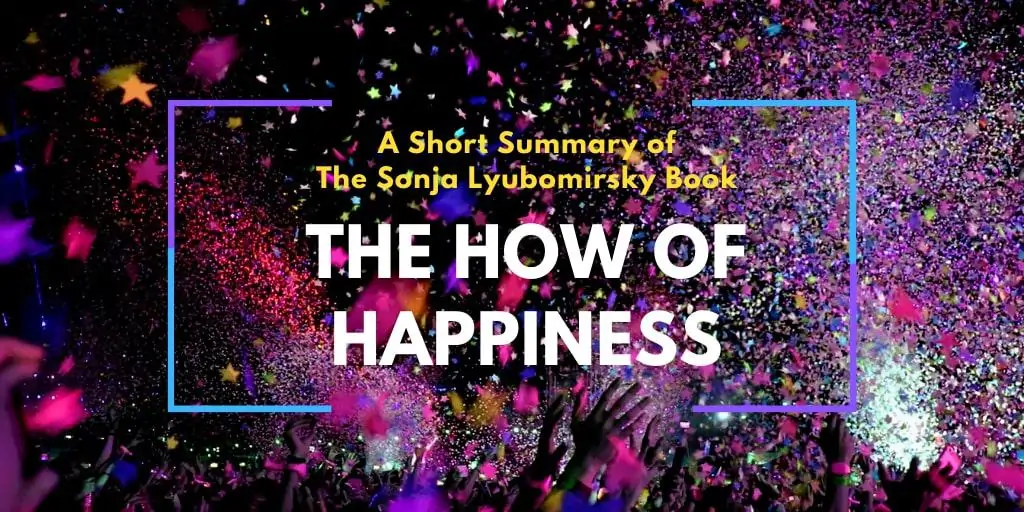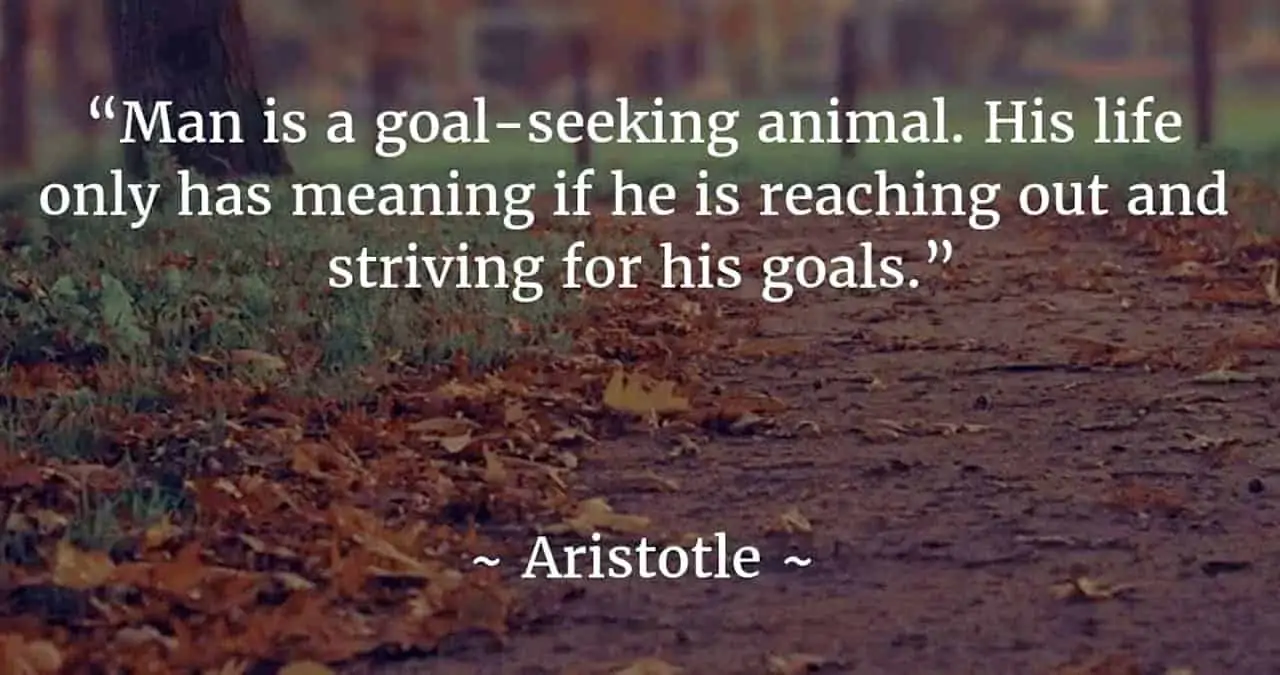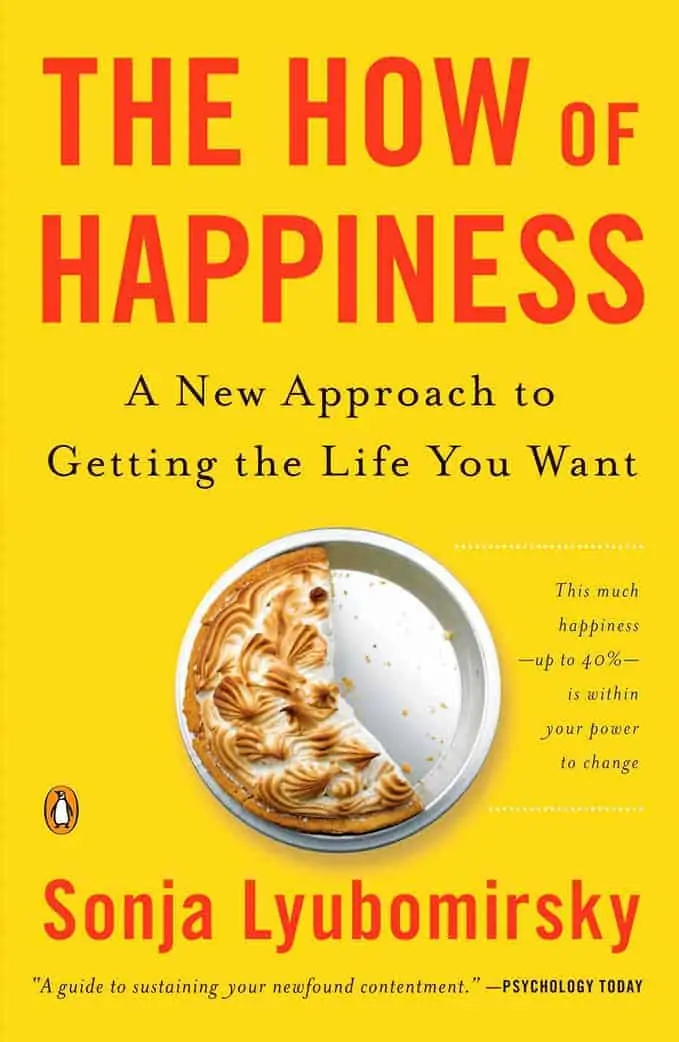Today's Saturday • 17 mins read
— By Dr. Sandip Roy.
I have been into positive psychology and happiness science for a decade. Allow me to present an insightful summary of Sonja Lyubomirsky’s book The How of Happiness.
“Trying to become happier by changing external circumstances—even if they were not terrible to begin with—is unlikely to deliver great results.”
— Sonja Lyubomirsky
The How of Happiness: A New Approach to Getting the Life You Want is one of the most thorough and practical guides on the subject. You get to learn how to be happier using science, in a smart and fun way, from a pioneer in positive psychology.
Quick Summary:
Sonja Lyubomirsky’s book The How of Happiness lays out research-backed ways to boost your happiness and well-being. It helps you figure out your natural “happiness set point” and gives you a toolbox of over a dozen practical strategies (positive interventions) to cultivate more joy, build stronger relationships, and find deeper meaning in your life. If you want to overhaul your whole approach to happiness, get this book for a personalized, science-based plan to get you there.

What is “The How of Happiness” about?
“The How of Happiness” uses research from positive psychology to dispel our happiness myths and share practical happiness-boosting strategies.
For example, happiness fades over time, even if we think we’ll never be unhappy again after something good happens. The same with sadness.
- We quickly adjust to happy events — whether we had a huge success, married a beautiful person, got a lucrative promotion, or won the jackpot.
- We also do not remain sad after a terrible situation as long as we think — whether we get laid off from our 10-year-old job, given an unexpected divorce, or lose a loved one.
The author writes,
In this book, I describe strategies that you can start doing right away and that will immediately boost your feelings of well-being, even if you are deeply despondent.
The book is divided into three main parts.
- Part One examines whether we can become really and lastingly happier. And helps us grasp the keys to happiness and the limits of life events on our well-being. It also shows how to find happiness activities that fit our unique interests, values, and needs.
- Part Two shares specific happiness-boosting activities. Like practicing gratitude, optimistic thinking, social connections, managing stress, committing to personal goals, and practices like meditation, physical activity, and spirituality.
- Part Three reveals the five factors behind sustainable happiness: positive emotion, optimal timing and variety of activities, social support, motivation and commitment, and the development of positive habits.
9 Insights Summarized From The How of Happiness
1. Three easy ways to boost daily happiness: Mindfulness, Savoring, and Flow.
i. Mindfulness
Mindful people are happier, less worried, and more likely to succeed in their personal and work lives. They also do better when things get tough (a quality called resilience).
Mindfulness is being attentive to the “here & now”, with no judgment. A quick way to do it:
- Find a comfortable, distraction-free place to sit and settle in. Close your eyes or gaze softly ahead.
- Focus on your breathing. Bring your attention to the sensation of air moving in and out as you inhale and exhale. If your mind wanders, gently redirect your focus back to your breath.
- Bring awareness to your body. Scan your body from head to toe, noticing any sensations, tensions, or areas of relaxation. Stay curious and non-judgmental as you tune into the present moment.
Get our beginner’s guide to practice Mindfulness In 7 Steps (Beginner’s Guide).
ii. Savoring
Those who know how to savor, are happier.
Savoring is extending a happy moment by fully appreciating its presence and meaning in our lives.
You practice savoring when you take a moment to fully appreciate the delicious flavors of a favorite meal, the warmth of a loved one’s embrace, or the beauty of a sunset.
You could learn to build your savoring skills.
iii. Flow
People who experience regular Flow in their lives are happier.
Flow is a state of deep immersion in an activity — you are so intensely focused on the thing you’re doing that you lose the sense of time.
Three key conditions to reach the flow state:
- The activity should have a clear set of goals and provide immediate feedback, so you know how well you’re progressing.
- The challenge of the activity should be well-matched to your skills and abilities, neither too easy nor too difficult.
- The activity should allow you to focus your attention completely, minimizing distractions and the sense of self, immersing you in the present moment.
Learn how to get into “Flow” at work.
2. Marriage can give us a happiness boost that lasts ~2 years.
Marriage has an impact on your happiness, but a tiny one. The happiness boost of marriage lasts for an average of 2 years.
Lyubomirsky writes,
And although married people are happier than single ones, the effect of marriage on personal happiness is actually quite small; for example, in sixteen countries, 25 percent of married people and 21 percent of singles described themselves as “very happy.”
The book asks us not to tell newlyweds this bit of news, from a study by Lucas & Clark, 2003:
In a landmark study, residents of West Germany and East Germany, including citizens, immigrants, and foreigners—25,000 in all—were surveyed every year for fifteen years. Over the course of the study, 1,761 individuals got married and stayed married. Using this spectacular data set, scientists showed that alas, marriage has only a temporary effect on happiness. It appears that after the wedding husband and wife get a happiness boost for about two years and then simply return to their baseline in happiness, their set point.
Over time, a marriage or any other intimate relationship enters the phase of hedonic adaptation.
Both can feel bored and dissatisfied. They may start taking each other for granted and neglecting their partner’s needs. This can become a fuelling factor for divorce or breakup.
Professor Bella DePaulo asks us to read this every time we hear that getting married will make us happier.
What are the secrets to a long-term happy marriage after 2 years?
The book reveals that one vital secret to long-term happy marriages is how joyfully one responds to their partner’s successes.
When one partner shares good news, the other partner is as happy as if it were his/her own success. This leads to a big uptick in their relationship satisfaction.
- So, don’t quip, “I’m so happy for you.”
- Instead, say, “I’m so happy!”
Moreover, couples who idealize each other are less likely to lose love and satisfaction in their relationship. Idealizing is highlighting the strengths and virtues while minimizing the weaknesses and flaws.
Idealizing also works as a self-fulfilling prophecy, a psychological theory that says beliefs eventually turn real.
• Being Single: Single people are no less happy than married people. Singles can and do find their joy in other relationships, like friends, relatives, and groups.
3. Positive Aging strategies can boost happiness in old age.
It may surprise you that youth and early adulthood are not the sunniest times of our lives.
What research conclusively confirms is that older people are actually happier and more satisfied with their lives than younger people.
Happiness increases as we age, after around 40 years, and peaks after 60 years.
One key strategy for older people to get happier is to spend more time reminiscing — which is the act of retrieving autobiographical memories.
What reminiscing does is breed positive feelings and make the person feel more loved and protected.
The more time the seniors spend remembering their old times, the more positivity they add to their mood, morale, and self-esteem.
Find out how to grow old gracefully.
4. Following a faith or religion can actually make us happier.
• Religious people tend to have more security and meaning in life.
• Actively practicing divinity or spirituality is linked to better physical health, more pro-social behavior, and being more successful at keeping away from unhealthy behaviors such as smoking.
• Those who are religious are happier, healthier, and cope better when they fall into bad times. It may be because of the social support of their religious group.
5. Money can make us happier, but only up to a certain point.
What about using money to buy happiness?

• Research shows that as long as you meet your basic needs, it’s how you spend your money — not how much you possess — that influences your happiness more. The key is not in how financially successful you are, but what you do with it and how you deal it out.
• While on money and happiness, we must note humans are prone to hedonic adaptation. Hedonic adaptation is the notion that after positive (or negative) events, followed by an increase in positive (or negative) feelings, people return to a relatively stable, baseline level of affect (Diener, Lucas, & Scollon, 2006).
• So, if you keep on amassing wealth for the sake of it, it will not make you happier and happier — but less and less happy. Because you rapidly get used to that wealth.
• In short, money makes us happier, but only till our basic needs are met, and thereafter, when we spend it in certain happiness-boosting ways.
Learn these 7 Science-Based Truths About Money And Happiness.
6. Buying experiences can give us more happiness than buying things.
Research finds it is not the things that keep us happy for long, but our experiences. Things we collect lie outside us, while our experiences nest inside us.

Experiences are superior to goods and assets in making us happier because:
- First, most of the stuff we buy doesn’t change much after we have bought them. We adapt to them a great deal faster. Note the word: Adapt. This is the hedonic adaptation we talked about earlier.
- Second, an experience is in itself more social. We are more likely to share and relive our fond memories with others – much more than our stuff.
- The third reason experiences make us happier is that we are less likely to compare them to those of others. You don’t usually claim your holiday happiness was bigger than your friend’s, do you?
It does not take us long to start feeling that our prized acquisitions have been there forever. In time, they grow old and dull, and we get eager to replace them with new shiny things we’d again get adapted to soon.
In contrast, experiences grow in value and joy as time passes. A fun-filled weekend, a lovely dinner, or a meaningful conversation can get embossed into our memories and bring happiness every time we revisit them.
7. Charity or philanthropy (Altruism) increases our happiness.
Altruism is an action or behavior that benefits another person.
More specifically, we are being altruistic when we act out of concern for others without expecting any reward.
• Charity and altruism make us doubly happy. With altruism, both the giver and the receiver feel happier.
• When we give freely, we not only feel more positive about ourselves but also about those who receive – that they are worthy of our kindness and respect.
• When we’re charitable, we actively go out to reduce the distresses of poverty and suffering in the world. In the process, we distract ourselves from our own petty problems, gain a greater appreciation for our good fortune, and step away from our worries.
Altruism is the opposite of selfishness.
8. Setting goals and striving for success can bring us happiness.
All of us have goals in life that define us.
• When we pursue our life goals, it adds structure and purpose to our lives. They raise our self-esteem and self-confidence and make us creative and productive. Most often, each of our major life goals is made up of many smaller goals.
• When we achieve these small goals, each makes us happier. It starts a positive feedback loop. Those many moments of small joys now drive us toward our bigger goals.
• So you see, when we feel happy and good while striving towards our major life goals, we are more likely to keep working at it. Thus, happier people have greater chances of becoming successful.
• Happiness comes before success and drives it.

9. Expressing gratitude for things that you receive raises your joy.
• Those who are routinely grateful are more energetic and optimistic, have better mental and physical health, have better relationships, and are high on happiness.
• Feeling regularly grateful can bring us a bunch of benefits for physical and mental health.
• Eight Reasons Gratitude Makes You Happier:
- Gratitude encourages morality
- It raises self-worth and self-esteem
- It helps prevent hedonic adaptation
- It helps to stop comparing yourself to others
- It fosters the savoring of positive experiences
- It may reduce feelings of anger, resentment, and greed
- It can help you cope better with stressful and traumatic events
- help build new social bonds and strengthen existing ones
Lyubomirsky writes:
They also tend to be more helpful and empathetic, more spiritual and religious, more forgiving, and less materialistic…[and] less likely to be depressed, anxious, lonely, envious, or neurotic.
• Find out how to build your gratitude muscle.

12 Happiness Activities From The How of Happiness
We can create our own happiness.
Forty percent of our happiness depends on the activities we do with intention. Experts call these activities positive interventions. We could call them happiness interventions or happiness-boosing actions.
Lyubomirsky lays down the following twelve interventions to do to increase our happiness:
- Savoring life’s joys
- Learning to forgive
- Expressing gratitude
- Cultivating optimism
- Nurturing relationships
- Taking care of your body
- Committing to your goals
- Practicing acts of kindness
- Developing strategies for coping
- Practicing religion and spirituality
- Doing more activities that truly engage you
- Avoiding overthinking and social comparisons
These strategies above do not involve making major shifts to one’s current life situations and can be used by anyone, whatever their genetic makeup.
A positive intervention (or happiness intervention) is an evidence-based, intentional act or series of actions (behavioral strategy) meant to increase (away from zero) that which causes or constitutes well-being and flourishing in non-clinical populations.
However, she does not decree to you to start practicing all twelve. Instead, she thoughtfully offers a Person-Activity Fit Diagnostic scale to find out which activities could be the best for your personality and asks you to pick from those your 4 best-fitting happiness strategies.
What Determines Your Happiness
According to research, half of our happiness is determined by our genes, and most of the rest by our intentional activities, while the remaining by our circumstances. Professor Lyubomirsky simplifies the research with a pie chart that she calls happiness pizza.
Look at the picture below:

What The Happiness Pie Chart tells us is 50% of our happiness (the blue part in the figure) is determined by our genes, called the happiness set point. And 40% (the green area) comes from our intentional activity, while the rest 10% is decided by our circumstances or life events.
Sonja Lyubomirsky and her collaborator Ken Sheldon were given more than a million dollars by the National Institute of Mental Health to study and find out what makes happy people happy, and how to use that ken to raise the happiness of the general population.
In the preface, she writes: “The star of The How of Happiness is science. To my knowledge, this is the first how-to-become-happier book authored by someone who has actually conducted research revealing how people can achieve a greater sense of happiness in their lives. Every suggestion that I offer is supported by scientific research.”
Professor Lyubomirsky reveals in the opening pages this critical fact about happiness:
Our happiness doesn’t depend on our circumstances as much as we think.
How Much Of Your Happiness Can You Control
The fact is you can’t do much about that 50% of your genetic set point. So, if your parents are happy, you have got a big shot at being happy. The reverse also holds true.
And data-wise, your life’s happenings surprisingly make up only around 10% of your happiness. So, a lottery win or an unfortunate accident does not impact more than 10% of our overall happiness.
From the data, however, we get this highly practical insight to run away with:
You have the power to control 40% of your happiness.
You can make yourself happier by 40% directly through your actions and thoughts. You have to concur that forty percent is one hefty figure. So much so that in fact, one of the book’s original titles was The 40 Percent Solution.
Remaking yourself as a happier person, a new person, is entirely in your hands, if you are willing to bring to bear some effort and commitment.
— Sonja Lyubomirsky
What Things Do Not Make You Happy
We live our whole lives with many happiness myths. We don’t realize the list of what all do not make us happy is a long one.
If you think a new relationship, looking younger, losing weight, having more money, or a new job, will give you unending happiness, then you’re dead wrong.
Positive psychology says, the circumstances and changes that happen to us, however great, don’t affect our happiness too much.
We tend to settle back to our base level after any happiness boost we get from a positive life event. The reason behind this is a common quirk of human nature called hedonic adaptation.
Hedonic adaption means we quickly become habituated and inured to most of the changes in our lives.
Things we think are going to make us lastingly happy, actually do not make us lastingly happy. And the things we think are going to keep us forever sad, do not actually keep us forever sad.
Another myth about happiness is attaching an If or When to your happiness journey. Such as:
- I’ll be happy if that happens, or
- I’ll be happy when that happens.
Both are wrong.
How Can You Measure Your Happiness
The book lays out a way to measure your happiness before you begin, and after you end, the process of adding happiness interventions to your life. After all, how else would you know if you’re better off doing what it suggests?
The short four-question test Lyubomirsky and her colleagues devised for this is called the Subjective Happiness Scale. You could check out your level of general happiness here.
FAQs
Can you be happy after a breakup or divorce?
Do you need a partner to be happy?
Final Words
The How of Happiness Summary PDF
If you didn’t know, here’s how to pronounce the author’s name: Son-yuh Lyu-bo-mirs-ky.
Lyubomirsky holds a Ph.D. in Social and Personality Psychology from Stanford University and is one of the founding parents of the positive psychology movement.
√ Also Read: Find True Happiness: At Summary of “The Happiness Trap”
√ Please spread the word if you found this helpful.
• Our Story!